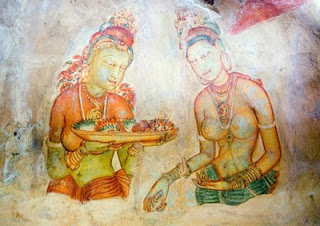Sigiriya is
In the 5th Century A.D. the rock resembled a recumbent lion with an artificial head built of bricks, resting on two enormous lion paws hewn out of the rock. Between these paws was a steep stairway that led to the magnificent palace of King Kassapa
Sigiriya was later handed over to the Buddhist clergy, who used it as a monastery up till the 14th century. Then it fell into disuse until rediscovered by the British in the 19th Century.
The picturesque road leading to the base of the rock is through well laid out gardens, fountains, pools covered with lotuses and birds of bright plumage that dart in and out of the trees.
It is a long climb to the top over boulders linked by limestone stairs. Protective handrails make the ascent easier. But half way up, one encounters a fabulous sheltered gallery covered by rock paintings of beautiful sensuous women, reminiscent of the Ajanta frescoes in India
Beyond the fresco gallery, there are steps clinging to the sides of the rock. They are protected from the elements by a wall three metres high, which is glazed on the inside, and has retained its shine over the last 1000 years. It is called the Mirror Wall and graffiti scribbled on its surface describe the impressions of visitors about these gorgeous damsels painted in the gallery. Only about 685 of these have been deciphered. They are written in Singhalese or Tamil. But for those curious to know what they mean, English translations can be found in any tourist guide book.
“The ladies who wear golden chains on their breasts beckon me. As I have seen these ladies, heaven appears to me not so good.”
“Hail golden coloured one on the mountainside, whose resplendent rosy hand bore a blue water lily, bewitched my heart and tore it from another.”
One from a jealous female scribbler says, “A dew-eyed female from the mountainside arouses anger in my mind. In her hand she has taken a string of pearls and in her looks she has assumed rivalry of us.”
Who were these ‘cloud maidens’ of Sigiriya? Archeologists and historians have voiced their own views. Some suggested that they represent ‘Lightening’ and ‘Clouds.’ Others believe that they are ladies from King Kassapa’s court in a devotional procession to the shrine of Pidurangala. Some call them ‘apsaras’ and others say these are artistic depictions of court life and its expressions of royal shenanigans.
But as Sigiriya was used as a Buddhist monastery, the common belief is that these frescoes are representation of the Goddess Tara, who is worshipped in many centres of Mahayana Buddhism. She is a heavily jewelled deity who dresses in colours of red, yellow, green or blue and holds a water lily or lotus in her hand.
Whoever these frescoes depict and however old they may be, they cast a magic spell on viewers who climb the Sigiriya rock all the way to the top.









